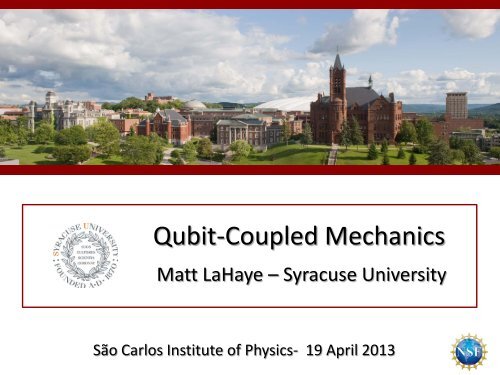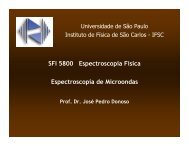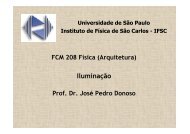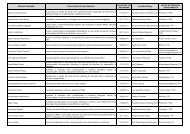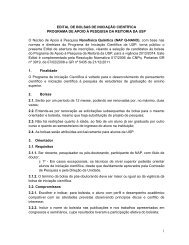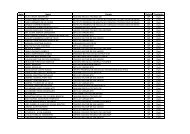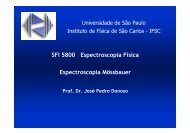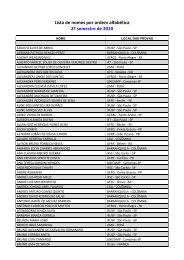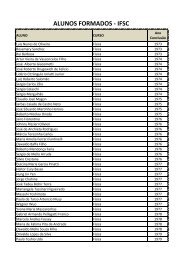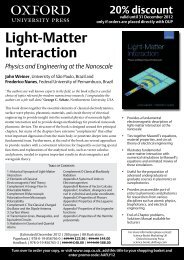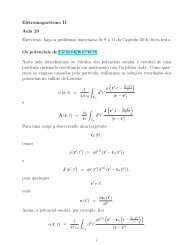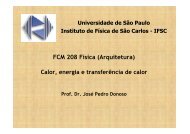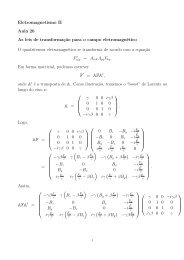Qubit-Coupled Mechanics - IFSC
Qubit-Coupled Mechanics - IFSC
Qubit-Coupled Mechanics - IFSC
You also want an ePaper? Increase the reach of your titles
YUMPU automatically turns print PDFs into web optimized ePapers that Google loves.
<strong>Qubit</strong>-<strong>Coupled</strong> <strong>Mechanics</strong><br />
Matt LaHaye – Syracuse University<br />
São Carlos Institute of Physics- 19 April 2013
Mechanical Systems in the Quantum Regime<br />
Develop and study mechanical quantum devices; devices which under ordinary<br />
conditions are perfectly well-described by classical laws of physics<br />
Devices like:<br />
Microtoroid Resonators<br />
Nanomechanical Beams<br />
Cleland & Roukes<br />
Kippenberg<br />
Just a small subset of types of devices being explored.<br />
*See M.Poot & H.S. van der Zant, Physics Reports 2012,<br />
for a recent and comprehensive review of devices*<br />
LIGO<br />
Macroscopic<br />
Mirrors
Mechanical Systems in the Quantum Regime<br />
Develop and study mechanical quantum devices; devices which under ordinary<br />
conditions are perfectly well-described by classical laws of physics<br />
Devices like:<br />
Microtoroid Resonators<br />
Nanomechanical Beams<br />
Cleland & Roukes<br />
Kippenberg<br />
Vibrational modes normally<br />
‘ring’ as one would expect<br />
for classical S.H.O.<br />
e.g. well-defined x and p;<br />
Continuous energy spectra<br />
LIGO<br />
Macroscopic<br />
Mirrors
Mechanical Systems in the Quantum Regime<br />
No reason that we know of why the motion of such objects shouldn’t<br />
exhibit characteristics of quantum S.H.O. (under the right conditions)<br />
Roukes<br />
Cantilever in a quantum superposition<br />
of spatially-separated states<br />
From Schwab & Roukes,<br />
Phys. Today 2005<br />
m<br />
k<br />
x<br />
Discrete Energy<br />
Levels<br />
Zero-point<br />
fluctuations
What do We Hope to Accomplish With These Studies?<br />
Fundamental studies of quantum mechanics<br />
- Perform experiments to shed light on fundamental issues with QM (e.g.<br />
quantum-classical ‘boundary’; the measurement problem)<br />
Development of new technologies<br />
- Quantum information<br />
- Bio-sensing and imaging<br />
- …<br />
e.g.<br />
Long-distance quantum communication<br />
Studying new frontiers in nature<br />
- Gravitational wave detection<br />
- Energy transfer at the nanoscale and<br />
non-equilbrium fluctuation theorems<br />
e.g.<br />
LIGO interferometer<br />
Rabl, Lukin et al.
Hybrid Quantum Systems<br />
Individual spins coupled to a cantilever<br />
LaHaye (SU); Roukes & Schwab (Caltech)<br />
Rugar (IBM, Almaden)<br />
Bose-Einstein Condensate <strong>Coupled</strong> to Cantilever<br />
Treutlein (Basel)<br />
Superconducting ‘QUBIT’ coupled to nanobeam<br />
Integrating mechanical, atomic,<br />
optical, microwave, spin and<br />
solid-state quantum systems<br />
A veritable toolbox of quantum<br />
systems at our disposal!
The Future: Quantum Machines?
Outline<br />
• Getting to the quantum regime of mechanics<br />
• <strong>Qubit</strong>-coupled mechanics:<br />
An important system for manipulating/measuring<br />
quantum states of motion<br />
Future prospects and experiments that are in the<br />
works at Syracuse
What does it take to get to the quantum<br />
regime of mechanics?
What does it take to see quantum behavior of<br />
mechanical objects?<br />
- Extensive subject<br />
- Lots of subtleties related to measurement, the<br />
nature of various quantum states of motion, and to<br />
the interaction of harmonic systems with their<br />
Environment<br />
- Book by Braginsky is a great place to start (began<br />
thinking about these issues in the context of<br />
gravitational wave detection back in the 1970’s)<br />
*Another nice, general overview: Schwab and Roukes,<br />
Physics Today, July 2005.*
Thermal Noise<br />
E<br />
Energy Spectrum<br />
The Environment: (e.g. charge fluctuations ;<br />
phonons from substrate, EM radiation, etc)<br />
Energy levels only account Roukes for<br />
KE and PE due to restoring force<br />
PE<br />
ħω 0<br />
Oscillator<br />
Embedded in<br />
an ‘environment’<br />
H = 1 2 k 0χ̂0 2 + p̂0 2<br />
2m 0<br />
KE<br />
E = ħω 0 N + 1 2<br />
N = 1<br />
N = 0<br />
N = 3<br />
N = 2<br />
x<br />
Environment is<br />
Source of random<br />
fluctuations that ‘kick’<br />
And damp resonator.<br />
Nanoresonator as S.H.O.<br />
k<br />
m x<br />
Environment<br />
Temp. T
Thermal Noise<br />
B-E: p N = NN /(N + 1) N+1<br />
The Environment: (e.g. charge fluctuations ;<br />
phonons from substrate, EM radiation, etc)<br />
E<br />
Energy Spectrum<br />
ħω<br />
Energy levels only account Roukes for<br />
Rule of Thumb: KE and PE due to restoring force<br />
Need k BT<br />
≲ 1 PE<br />
ħω<br />
Oscillator<br />
Embedded in<br />
an ‘environment’<br />
H = 1 2 k 0χ̂0 2 + p̂0 2<br />
2m 0<br />
KE<br />
If k B T ≫ ħω<br />
In equilibrium:<br />
N = 1<br />
N = 0<br />
N = 3<br />
N = 2<br />
x<br />
Environment is<br />
Source of random<br />
fluctuations that ‘kick’<br />
And damp resonator.<br />
→ E ~k B T Fluctuations ‘wash out’ discrete levels<br />
Nanoresonator as S.H.O.<br />
m<br />
k<br />
x<br />
Environment<br />
Temp. T
Chasing the Ground State<br />
Cooling the environment (or, equivalently, increasing ω)<br />
Thermal Occupation Vs. Temperature<br />
For Several different frequencies (ω/2π)<br />
Dashed lines are average<br />
# of quanta N tt ≈ k B T/ħω<br />
(solid lines: BE occupation factor)<br />
N tt<br />
Frequencies correspond to<br />
typical nano/micro-mechanical<br />
fundamental mode<br />
‘Freeze- out’ to<br />
Quantum regime<br />
T (mm)<br />
This temperature regime<br />
Accessible with standard<br />
Cryogenic methods
Approaching the Ground State<br />
Cleland et al., Nature, 2010<br />
Dilatational oscillator<br />
ω 0<br />
2π ~ 6 GGG!<br />
k B T<br />
ħω 0<br />
~1 at ~ 300 mm!<br />
Cleland et al. put this device on a dilution refrigerator<br />
and cooled it down so that N tt < . 1!
Approaching the Ground State: Back-Action Cooling<br />
Use the measurement process to cool mechanical mode!<br />
Schwab et al. Nature 2010<br />
Micro<br />
‘drum head’<br />
Teufel et al. Nature 2011<br />
N tt = 3. 8<br />
Coherent State Transfer<br />
Palomaki et al. Nature 2013<br />
N tt =0.34<br />
Observation of zero-point fluctuations<br />
Safavi-Naeini et al. PRL 2012<br />
Optomechanical crystal<br />
Chan, Alegre, et al. Nature 2011<br />
In these examples, a mechanical mode is<br />
coupled to EM cavity, which does work on<br />
the mode cooling it below environment T<br />
*See M.Poot & H.S. van der Zant, Physics Reports,<br />
for a recent and comprehensive review *<br />
N tt =0.85
Now that mechanical structures have been<br />
cooled near the ground state, how do you<br />
prepare and measure quantum states of these<br />
structures?
Limitations of Linear Displacement Detectors<br />
Typically, displacement transducers are linear<br />
x<br />
k<br />
m<br />
Linear<br />
Detector<br />
Output is linearly proportional to x<br />
Obviously, many examples: capacitive, magnetomotive, piezoelectric, transistor current<br />
However, linear detectors generally should drive resonator into<br />
‘classical-like’ states, coherent states of motion<br />
Coherent<br />
State<br />
|α(t)⟩ = e −iωω− α 2 (αe−iii ) n<br />
|n⟩<br />
n!<br />
∞<br />
n=0<br />
x(t) =<br />
ħ<br />
mω<br />
α cosωω
<strong>Qubit</strong>-<strong>Coupled</strong> <strong>Mechanics</strong><br />
First proposed by A. Armour, M. Blencowe & K. Schwab: PRL 88 (2002) & Physica B 316 (2002).<br />
Cooper-pair box (CPB) charge qubit<br />
Nano-electromechanical resonator<br />
+<br />
Nakamura et al., Nature, 398 29 Apr. 1999 Cleland & Roukes, APL 69 28 Oct. 1996<br />
electrostatic interaction<br />
=<br />
artificial<br />
atom<br />
λ<br />
x<br />
|2><br />
|1><br />
|0><br />
|n><br />
Harmonic oscillator<br />
<strong>Qubit</strong>- coupled<br />
resonator analogous<br />
to atom-coupled<br />
photon cavity
Schematic of Coupling Between a Cooper-Pair Box<br />
(CPB) Charge <strong>Qubit</strong> and Nanoresonator<br />
Flexural motion of resonator modulates CPB electrostatic energy<br />
Pauli Matrices<br />
V NR<br />
d<br />
CPB <strong>Qubit</strong><br />
B<br />
J. Junctions<br />
V g<br />
σ z = 1 0<br />
0 −1<br />
nanoresonator<br />
Aluminum<br />
C NR<br />
N or N+1<br />
Charges<br />
(Cooper-Pairs)<br />
Silicon Nitride<br />
σ x = 0 1<br />
1 0<br />
Full Hamiltonian<br />
Interaction strength<br />
H = E ee V g σ z<br />
CPB<br />
electrostatic<br />
Energy<br />
+ E J B σ x + ħω a † a + 1 + ħλ(a † + a) ∙ σ<br />
2<br />
z<br />
CPB<br />
Josephson<br />
Energy<br />
NR<br />
displacement<br />
CPB<br />
charge
Schematic of Coupling Between a Cooper-Pair Box<br />
(CPB) Charge <strong>Qubit</strong> and Nanoresonator<br />
Flexural motion of resonator modulates CPB electrostatic energy<br />
V NR<br />
d<br />
nanoresonator<br />
Aluminum<br />
CPB <strong>Qubit</strong><br />
C NR<br />
B<br />
N or N+1<br />
Charges<br />
(Cooper-Pairs)<br />
J. Junctions<br />
V g<br />
Silicon Nitride<br />
Full Hamiltonian<br />
Full Hamiltonian is<br />
formally analogous to<br />
the Jaynes-Cummings<br />
Hamiltonian in quantum<br />
Optics/CQED<br />
See E.K. Irish and K.C. Schwab,<br />
PRB, 2004 for more details.<br />
Also, Haroche/Raimond, Exploring<br />
the Quantum for JC in general<br />
Interaction strength<br />
H = E ee V g σ z<br />
CPB<br />
electrostatic<br />
Energy<br />
+ E J B σ x + ħω a † a + 1 + ħλ(a † + a) ∙ σ<br />
2<br />
z<br />
CPB<br />
Josephson<br />
Energy<br />
NR<br />
displacement<br />
CPB<br />
charge
Schematic of Coupling Between a Cooper-Pair Box<br />
(CPB) Charge <strong>Qubit</strong> and Nanoresonator<br />
Flexural motion of resonator modulates CPB electrostatic energy<br />
V NR<br />
d<br />
CPB <strong>Qubit</strong><br />
B<br />
J. Junctions<br />
V g<br />
Question: How can<br />
one use this to observe<br />
quantum properties<br />
of the nanoresonator?<br />
C NR<br />
nanoresonator<br />
Aluminum<br />
N or N+1<br />
Charges<br />
(Cooper-Pairs)<br />
Silicon Nitride<br />
Full Hamiltonian<br />
See E.K. Irish and K.C. Schwab,<br />
PRB, 2004 for more details.<br />
Also, Haroche/Raimond, Exploring<br />
the Quantum for JC in general<br />
Interaction strength<br />
H = E ee V g σ z<br />
CPB<br />
electrostatic<br />
Energy<br />
+ E J B σ x + ħω a † a + 1 + ħλ(a † + a) ∙ σ<br />
2<br />
z<br />
CPB<br />
Josephson<br />
Energy<br />
NR<br />
displacement<br />
CPB<br />
charge
The Dispersive Coupling Limit<br />
Typically ħλ ≪ ΔE − ħω<br />
Full Hamiltonian<br />
H = E ee V g σ z + E J B σ x + ħω a † a + 1 2 + ħλ(a† + a) ∙ σ z<br />
Some typical parameters<br />
λ ~ 1 − 10 ′ s MHz<br />
ΔE ~ 1 − 10 ′ s GHz<br />
Coupling Strength<br />
CPB Energy Scale<br />
Interaction results in<br />
simple shifts in energies of<br />
the two systems<br />
(Dispersive or non-resonant<br />
Coupling limit)<br />
where<br />
ΔE =<br />
ω ~ 10 ′ s − 100 ′ s MHz<br />
E 2 2<br />
ee + E J<br />
Mechanical Frequency<br />
The dispersive shift of each<br />
system depends on the<br />
state of the other system<br />
*See: Irish & Schwab, PRB 68, 155311 (2003); Haroche & Raimond, Exploring the Quantum: Atoms, Cavities & Photons*
The Dispersive Coupling Limit<br />
Interaction Leads to Shift in Energy of CPB and NEMS<br />
Analogous To dispersive shifts in CQED<br />
Two Dispersive Effects Occur<br />
CPB-state-dependent<br />
Frequency<br />
Shift in NR<br />
Analogous to single-atom<br />
refractive shift in CQED<br />
δω ± ≈ ±ħλ 2 /ΔE<br />
Energy levels w/o interaction<br />
N = 2<br />
N = 1<br />
N = 0<br />
…<br />
…<br />
ħω 0<br />
∆E<br />
|−⟩ |+⟩<br />
Energy levels with interaction<br />
2<br />
1<br />
NR- dependent<br />
shift in CPB<br />
transition energy<br />
N ≡ # Quanta in NR<br />
Analogous<br />
to Lamb Shift<br />
δE ≈ ħλ 2 (2N + 1)/ΔE<br />
Analogous<br />
to Stark Shift<br />
N = 2<br />
N = 1<br />
N = 0<br />
…<br />
…<br />
ħω +<br />
0<br />
ħω −<br />
∆E + δδ<br />
|−⟩ |+⟩<br />
1<br />
*See: Irish & Schwab, PRB 68, 155311 (2003)<br />
ω ± = ω + δω ±
First Realization of <strong>Qubit</strong>-<strong>Coupled</strong> Nanoresonator<br />
NR Response with No Coupling to <strong>Qubit</strong><br />
CPB<br />
<strong>Qubit</strong>
First Realization of <strong>Qubit</strong>-<strong>Coupled</strong> Nanoresonator<br />
NR Response <strong>Coupled</strong> to <strong>Qubit</strong> in Ground State<br />
CPB<br />
<strong>Qubit</strong><br />
Expect (-) Shift:<br />
δω − ≈ −ħλ 2 /ΔE
Nanomechanical Probe of Quantum Interference<br />
in a CPB <strong>Qubit</strong><br />
From M.D. LaHaye et al., Nature 459 , 960 (2009).<br />
Positive Frequency<br />
Shift of <strong>Mechanics</strong><br />
<strong>Qubit</strong> in Excited<br />
State on Average<br />
Frequency Shift of<br />
<strong>Mechanics</strong> ∆ ω /2π NR (Hz)<br />
2.5<br />
2.0<br />
-400 -200 0 200 400 600<br />
V rf<br />
V (V) µ<br />
(V)<br />
Gave us confirmation that 1.5simple JC model captured the physics of this qubit-coupled<br />
Mechanical devices (at least in the dispersive limit).<br />
1.0<br />
Negative Frequency<br />
Shift of <strong>Mechanics</strong><br />
<strong>Qubit</strong> in Ground<br />
State On Average<br />
0.5<br />
-4<br />
-3<br />
-3<br />
-10.0 -8.0 -6.0 -4.0 -2.0<br />
V<br />
V cpb<br />
(mV)<br />
0 (V)<br />
φ is a function of<br />
<strong>Qubit</strong> parameters V rf and V 0<br />
-4<br />
<strong>Qubit</strong>’s State Vector<br />
|Ψ(t)⟩ = Ψ − (t)|−⟩ + Ψ(t) + |+⟩<br />
Ψ − (t) ∝ sin (φ)<br />
Ψ + (t) ∝ cos (φ)
Milestone in Quantum Measurement<br />
Nature April 1 2010<br />
UCSB Group<br />
Resonant Limit (∆E ≈ ω) of Jaynes-Cummings<br />
<strong>Qubit</strong> Excited<br />
State probability<br />
H = ∆Eσ z + ħω a † a + 1 2 + ħλ(a† σ − + aσ + )<br />
<strong>Qubit</strong>-Resonator Swap Quanta
The Dispersive Coupling Limit<br />
*See: Irish & Schwab, PRB 68, 155311 (2003)<br />
Interaction Leads to Shift in Energy of CPB and NEMS<br />
Analogous To dispersive shifts in CQED<br />
Two Dispersive Effects Occur<br />
CPB-state-dependent<br />
Frequency<br />
Shift in NR<br />
NR- dependent<br />
shift in CPB<br />
transition energy<br />
N ≡ # Quanta in NR<br />
χ = 2λ 2 /ΔE<br />
Analogous to single-atom<br />
refractive shift in CQED<br />
δω ± ≈ ±ħχ<br />
Analogous<br />
to Lamb Shift<br />
δE ≈ ħχ(2N + 1)<br />
Analogous<br />
to Stark Shift<br />
Energy levels w/o interaction<br />
N = 2<br />
N = 1<br />
N = 0<br />
…<br />
…<br />
…<br />
ħω 0<br />
∆E<br />
|−⟩ |+⟩<br />
Energy levels with interaction<br />
N = 2<br />
N = 1<br />
N = 0<br />
∆E + 3ħχ<br />
…<br />
∆E + ħχ<br />
|−⟩ |+⟩<br />
2<br />
1<br />
1<br />
0<br />
Dispersive interaction is non-destructive: H iii ∝ σ z ⋅ a † a ⇒ H 0 , H iii = 0
The Dispersive Coupling Limit<br />
*See: Irish & Schwab, PRB 68, 155311 (2003)<br />
Interaction Leads to Shift in Energy of CPB and NEMS<br />
Analogous To dispersive shifts in CQED<br />
Two Dispersive Effects Occur<br />
CPB-state-dependent<br />
Frequency<br />
Shift in NR<br />
NR- dependent<br />
shift in CPB<br />
transition energy<br />
N ≡ # Quanta in NR<br />
χ = 2λ 2 /ΔE<br />
Analogous to single-atom<br />
refractive shift in CQED<br />
δω ± ≈ ±ħχ<br />
Analogous<br />
to Lamb Shift<br />
δE ≈ ħχ(2N + 1)<br />
Analogous<br />
to Stark Shift<br />
Energy levels w/o interaction<br />
N = 2<br />
N = 1<br />
N = 0<br />
…<br />
…<br />
…<br />
ħω 0<br />
∆E<br />
|−⟩ |+⟩<br />
Energy levels with interaction<br />
N = 2<br />
N = 1<br />
N = 0<br />
∆E + 3ħχ<br />
…<br />
∆E + ħχ<br />
|−⟩ |+⟩<br />
2<br />
1<br />
1<br />
0<br />
Measurements of Stark shift just recently done in the high-N limit: Pirkklainen et al. Nature 2013
Next step: Dispersive measurements of the number-state<br />
statistics of a mechanical mode<br />
Perform spectroscopy on the qubit<br />
while it is coupled to the<br />
mechanical resonator<br />
ω<br />
= 300 MHz<br />
2π<br />
χ<br />
= 0.6 MHz<br />
2π<br />
k B T~1.7ħω<br />
<strong>Qubit</strong> Linewidth<br />
γ qq<br />
= 0.5 MHz<br />
2π<br />
Absorption spectrum of qubit<br />
for nanoresonator in thermal<br />
state at T = 25 mm<br />
Absorption<br />
Rate (A.U.)<br />
*Calculations based on CLERK & UTAMI, PRA 75, 042302 (2007)<br />
‘Stark’-Shifted <strong>Qubit</strong> Transitions<br />
N = 2<br />
N = 1<br />
N = 0<br />
…<br />
N = 0<br />
Simulation of Stark Shift<br />
…<br />
∆E + ħχ<br />
|−⟩ |+⟩<br />
2<br />
∆E + 5ħχ<br />
1<br />
∆E + 3ħχ<br />
N = 1<br />
0.1 1.0 10<br />
ω s − ΔE (MHz)<br />
0<br />
N = 2
Engineering the qubit read-out: Embed <strong>Qubit</strong>-<strong>Mechanics</strong> in<br />
Superconducting LC Circuit<br />
ω p<br />
∼<br />
50 Ω Feedline<br />
Cryo Amp<br />
L<br />
C<br />
C Q<br />
<strong>Qubit</strong> State Changes LC Frequency - Probe By Transmission Measurement of Feedline
Engineering the qubit read-out: Embed <strong>Qubit</strong>-<strong>Mechanics</strong> in<br />
Superconducting LC Circuit<br />
Probe qubit state |±⟩ via ‘pull’<br />
of LC resonator frequency<br />
0<br />
Feedline Transmission Simulation<br />
<strong>Qubit</strong> Capacitance<br />
If qubit is in |−⟩, C Q > 0<br />
If qubit is in |+⟩, C Q < 0<br />
S21<br />
Amp<br />
(dB)<br />
-4<br />
-8<br />
-12<br />
|−⟩<br />
|+⟩<br />
1.768 1.772 1.776 1.780 1.784<br />
Probe Frequency - ω p /2π (GHz)
Present Status of Our Efforts at Syracuse - Lab<br />
Dilution fridge cooled down for<br />
first time on 11/3/11.<br />
Base Temp. < 33 mm!<br />
LaHaye Lab<br />
Research Team<br />
NSF-DMR Career Award: #1056423<br />
Postdoc<br />
Francisco<br />
Rouxinol<br />
Visiting Scientist<br />
Seung-Bo Shim<br />
Grad Student<br />
Hugo Hao
Present Status of Our Efforts at Syracuse – LC<br />
Circuit Read-out of Superconducting <strong>Qubit</strong><br />
Making samples at Cornell<br />
Nanofabrication Facility (CNF) and in<br />
the Plourde Lab at SU<br />
Coupling<br />
To LC<br />
50 Ω feedline<br />
<strong>Qubit</strong><br />
nanoresonator<br />
LC Circuit<br />
*Fabrication By: Francisco Rouxinol and Seung-Bo Shim<br />
*Measurements By: Hugo Hao, MDL, FR & SBS<br />
LC and Ground Plane: Niobium<br />
Nanoresonator and <strong>Qubit</strong>: Aluminum<br />
Signal Amplitude (nV)<br />
100<br />
10<br />
1<br />
Feedline Transmission Measurements<br />
.5Φ 0 change<br />
in Φ to qubit<br />
Q i ~ 12 − 15 × 10 3<br />
Q c ~ 300 − 350<br />
1.938 1.944 1.950 1.956<br />
Probe Frequency - ω p /2π (GHz)
LC Circuit Read-out of <strong>Qubit</strong> vs. Applied B-field<br />
• LC response modulates<br />
periodically with applied<br />
magnetic field:<br />
E J ∝ cos (πΦ/Φ 0 )<br />
LC Probe Frequency (GHz)<br />
1.96<br />
1.95<br />
1.94<br />
Amplitude<br />
0.0<br />
-5.0<br />
-10.0<br />
Transmission Amplitude (dB)<br />
LC Probe Frequency (GHz)<br />
1.96<br />
1.95<br />
1.94<br />
Phase<br />
*fridge temperature ≲ 30 mK*<br />
1.0<br />
0.5<br />
0.0<br />
-0.5<br />
Transmission Phase (rad.)<br />
-5.0 5.0 15.0 25.0 35.0<br />
Magnet Current (mA)
LC Circuit Read-out of <strong>Qubit</strong> vs. Applied B-field<br />
• LC response modulates<br />
periodically with applied<br />
magnetic field:<br />
E J ∝ cos (πΦ/Φ 0 )<br />
• Model parameters<br />
• E C = 1.3 GGG<br />
• E J = 12.7 GGG<br />
• λ/2π = 160 MMM<br />
• ω/2π = 1.945 GGG<br />
• General agreement with<br />
Jaynes-Cummings Model<br />
for qubit-coupled LC<br />
• Model Needs Improvement<br />
• Charge noise<br />
• Finite temperature<br />
LC Probe Frequency (GHz)<br />
LC Probe Frequency (GHz)<br />
1.96<br />
1.95<br />
1.94<br />
1.96<br />
1.95<br />
1.94<br />
___<br />
…….<br />
Amplitude<br />
Phase<br />
<strong>Coupled</strong> qubit & LC<br />
Uncoupled qubit &LC<br />
*fridge temperature ≲ 30 mK*<br />
-1.5 0.5 0.5 1.5<br />
Magnetic Flux (πΦ/Φ 0 )<br />
0.0<br />
-5.0<br />
-10.0<br />
1.0<br />
0.5<br />
0.0<br />
-0.5<br />
Transmission Amplitude (dB)<br />
Transmission Phase (rad.)
Details of the UHF Flexural Nanomechanical Resonator<br />
Close Up of Nanoresonator<br />
Resonator Geometric Properties<br />
- ~100 nm thick aluminum<br />
- 200 nm width<br />
- 1.8 micron length<br />
- Expect in-plane f 0 ~ 300 MHz<br />
Resonator etched using SF 6 RIE etch<br />
Engineered 70 nm gap between<br />
Al resonator and Al qubit electrode<br />
COMSOL Simulation:<br />
<strong>Qubit</strong>-Resonator Capacitance ~ 180 aF*<br />
*Should yield strong qubit-nanoresonator<br />
Coupling (λ/2π~10 ′ s MHz)*<br />
*Fabrication By: Francisco Rouxinol and Seung-Bo Shim
Details of the UHF Flexural Nanomechanical Resonator<br />
Close Up of Nanoresonator<br />
Resonator Geometric Properties<br />
- ~100 nm thick aluminum<br />
- 200 nm width<br />
- 1.8 micron length<br />
- Expect in-plane f 0 ~ 300 MHz<br />
COMSOL Simulation<br />
Calculated In-plane flexural<br />
fundamental mode: 291MHz<br />
Signal Amplitude (nV)<br />
0<br />
-40<br />
-80<br />
Preliminary Magnetomotive Measurements<br />
(On a 4K Probe Station)<br />
Q~1350<br />
0 Tesla<br />
7 Tesla<br />
Fit to EM<br />
Impedance<br />
288.7 289.0 289.3 289.6 289.9<br />
Drive Frequency - ω/2π (MHz)<br />
*Simulation and magnetomotive measurements by Seung-Bo Shim and Sang Goon Kim
LC Read-out of <strong>Qubit</strong>: Two-Tone Spectroscopy<br />
10<br />
<strong>Qubit</strong> Absorption Spectrum Vs. Magnetic Flux<br />
January 21st Data, 10dBm MW - Simulation: Ec=1.7GHz;Ej0=11.6GHz;<br />
15<br />
9<br />
10<br />
Microwave Frequency (GHz)<br />
Microwave Frequency (GHz)<br />
8<br />
7<br />
6<br />
5<br />
Want to Zoom-in<br />
Look for phonon<br />
Stark shift, but…<br />
<strong>Qubit</strong> transition energy<br />
model parameters:<br />
• E c =1.3 GHz<br />
• E j0 =11.9 GHz<br />
5<br />
0<br />
-5<br />
-10<br />
-15<br />
LC<br />
Phase<br />
(Deg.)<br />
4<br />
-1.5 -1 -0.5 0 0.5 1 1.5<br />
Flux (π)<br />
Flux (πΦ/Φ 0 )<br />
-20<br />
- Resonant microwaves applied to qubit modify the dispersive shift of the LC<br />
- Tuning flux modifies qubit transition via E J ∝ cos (πΦ/Φ 0 ) .
Two-Tone Spectroscopy – ‘Extra’ Features<br />
10<br />
<strong>Qubit</strong> Absorption Spectrum Vs. Magnetic Flux<br />
January 21st Data, 10dBm MW - Simulation: Ec=1.7GHz;Ej0=11.6GHz;<br />
15<br />
9<br />
10.5<br />
10<br />
Higher resolution spectroscopy<br />
Microwave Frequency (GHz)<br />
Microwave Frequency (GHz)<br />
8<br />
7<br />
6<br />
5<br />
What is the<br />
Extra Structure?<br />
4<br />
-1.5 -1 -0.5 0 0.5 1 1.5<br />
Flux (π)<br />
Flux (πΦ/Φ 0 )<br />
10.0<br />
9.5<br />
5<br />
0<br />
-5<br />
-10<br />
-0.5 0.0<br />
0.5<br />
-15<br />
-20<br />
LC<br />
Phase<br />
(Deg.)<br />
~300 MHz<br />
~300 MHz<br />
- ‘Extra’ structure looks like a series of avoided-level crossings<br />
- Can’t rule out multi-photon processes , longitudinal dressed states, etc. (e.g. ~10 photons in LC)
Two-Tone Spectroscopy – ‘Extra’ Features<br />
10<br />
<strong>Qubit</strong> Absorption Spectrum Vs. Magnetic Flux<br />
January 21st Data, 10dBm MW - Simulation: Ec=1.7GHz;Ej0=11.6GHz;<br />
15<br />
Microwave Frequency (GHz)<br />
Microwave Frequency (GHz)<br />
9<br />
8<br />
7<br />
6<br />
5<br />
Working with Fred and<br />
Amir Caldeira for model<br />
including LC,CPB & NR<br />
Unfortunately, sample<br />
destroyed before fully<br />
studied. .. We’re<br />
making new ones now.<br />
What is the<br />
Extra Structure?<br />
4<br />
-1.5 -1 -0.5 0 0.5 1 1.5<br />
Flux (π)<br />
Flux (πΦ/Φ 0 )<br />
- ‘Extra’ structure looks like a series of avoided-level crossings<br />
- Can’t rule out multi-photon processes , longitudinal dressed states, etc. (e.g. ~10 photons in LC)<br />
- Could it be related to the mechanical resonator? ~300 MHz spacing is suggestive<br />
10.5<br />
10.0<br />
9.5<br />
10<br />
Higher resolution spectroscopy<br />
5<br />
0<br />
-5<br />
-10<br />
-0.5 0.0<br />
0.5<br />
-15<br />
-20<br />
LC<br />
Phase<br />
(Deg.)<br />
~300 MHz<br />
~300 MHz
Conclusions<br />
- <strong>Mechanics</strong> has become a new quantum technology with<br />
many possible applications and potential for addressing<br />
fundamental questions in quantum mechanics<br />
- <strong>Qubit</strong>-mechanics will serve as an important test-bed for<br />
mechanical quantum systems. Analogous to what CQED has<br />
been for studying quantum properties of light.<br />
Experiments at Syracuse performed with<br />
Francisco Rouxinol & Hugo Hao - SYR<br />
Seung-Bo Shim & Sang Goon Kim - KRISS


